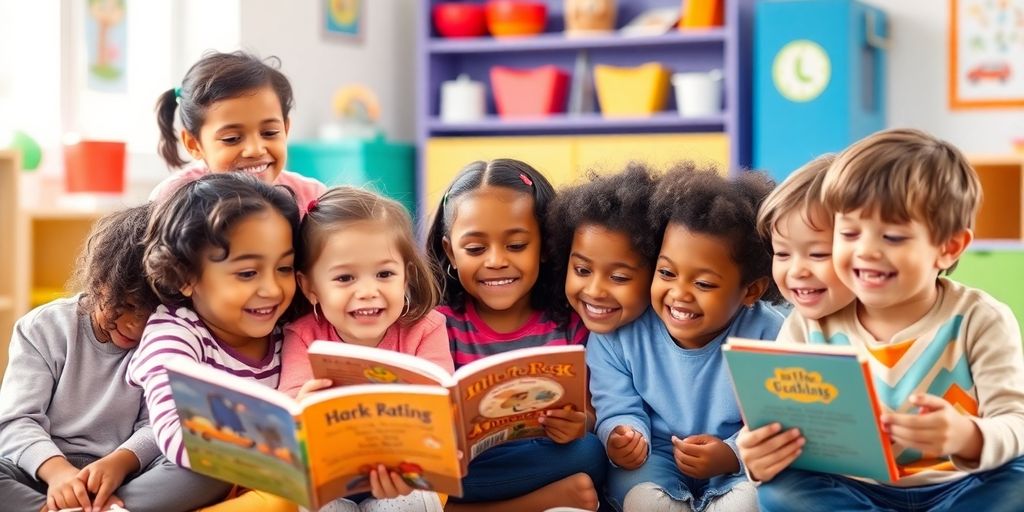Creating Effective Social Stories for Children with Autism
ABA TherapyJuly 17, 2025

Creating social stories for children with autism is a powerful way to help them understand social situations and expectations. These stories are tailored to meet individual needs, making them a valuable tool for parents and educators. By using simple language and relatable visuals, social stories can effectively support children in navigating their daily lives and improving their social skills.
Key Takeaways
- Social stories should be customized to address specific needs of each child.
- Consider the child's mood and the environment when sharing a social story.
- Introduce a social story before expecting the child to demonstrate the behavior it describes.
- Encourage the child to create and share their own stories to express their feelings and experiences.
- Use positive language and realistic visuals to enhance understanding and engagement.
Understanding Social Stories for Children with Autism
Definition and Purpose
A social story is a short narrative designed to help children with autism understand and navigate social situations. These stories use simple language and realistic images to explain what to expect in various scenarios. The main goal is to provide support, understanding, and growth opportunities for autistic children.
History and Development
Social stories were created by Carol Gray in 1990. She developed this method to assist her students in managing social situations at school. Over the years, the concept has evolved, and many educators and therapists now use social stories to help children with autism in various settings.
Key Elements of Social Stories
A well-crafted social story typically includes the following elements:
- Title: Clearly states the topic of the story.
- Introduction: Sets the scene or describes the situation.
- Descriptive Sentences: Provides information in a supportive manner.
- Visuals: Uses realistic images to enhance understanding.
- Conclusion: Ends on a positive note, reinforcing the message.
ElementDescriptionTitleClearly states the topic of the storyIntroductionSets the scene or describes the situationDescriptive SentencesProvides information in a supportive mannerVisualsUses realistic images to enhance understandingConclusionEnds on a positive note, reinforcing the message
Social stories can be a powerful tool for helping children with autism learn social skills and manage their emotions. They can be tailored to fit each child's unique needs and experiences, making them a versatile resource for parents and educators.
Creating Customized Social Stories

Identifying Specific Needs
To create effective social stories, it’s essential to first identify the specific needs of the child. This involves:
- Understanding their unique challenges and strengths.
- Considering their interests to make the story engaging.
- Assessing their communication abilities to tailor the language used.
Incorporating Realistic Visuals
Visuals play a crucial role in social stories. Here are some tips for incorporating them:
- Use realistic images that the child can relate to.
- Include pictures of familiar people and places.
- Ensure visuals are clear and not overly complex to avoid confusion.
Using Positive Language
The language in social stories should always be positive and supportive. This means:
- Using encouraging phrases that promote good behavior.
- Avoiding negative words that might cause anxiety.
- Keeping sentences simple and direct to enhance understanding.
Creating a social story that resonates with a child can significantly improve their ability to navigate social situations. Ownership of the story can empower them to express their feelings and choices effectively.
Effective Techniques for Telling Social Stories
Timing and Setting
When sharing social stories, it’s important to choose the right moment and environment. Here are some tips:
- Read during calm times: Avoid stressful moments; choose times when your child is relaxed.
- Create a comfortable space: A quiet area helps your child focus better.
- Use familiar routines: Integrate reading the story into daily activities, like bedtime or mealtime.
Engaging Your Child
To make social stories more effective, engage your child actively:
- Ask questions: Encourage your child to think about the story by asking open-ended questions.
- Use visuals: Incorporate pictures or drawings that relate to the story to capture their interest.
- Role-play scenarios: Act out parts of the story to help your child understand the situations better.
Reinforcing Positive Behaviors
After reading a social story, it’s crucial to reinforce the desired behaviors:
- Provide positive feedback: Praise your child when they demonstrate the behavior described in the story.
- Repeat the story: Regularly revisit the story to reinforce the lessons learned.
- Involve others: Share the story with family members or teachers to create a consistent message.
Social stories help autistic children learn appropriate responses to situations to decrease problem behavior and work on adverse reactions.
Examples of Social Stories
Daily Routine Stories
Social stories can help children understand their daily routines. Here are some examples:
- Morning Routine: Describing steps like brushing teeth, getting dressed, and having breakfast.
- School Day: Outlining what happens from arrival at school to going home.
- Bedtime Routine: Explaining activities like taking a bath, reading a story, and going to sleep.
Handling New Situations
When children face new experiences, social stories can prepare them. Examples include:
- Going to the Doctor: Explaining what to expect during a check-up.
- First Day of School: Describing meeting new teachers and making friends.
- Family Gatherings: Preparing for interactions with relatives and new environments.
Managing Emotions and Behaviors
Social stories can also assist in understanding feelings and behaviors. Here are some ideas:
- Feeling Angry: Teaching children that it’s okay to feel angry but showing them how to express it appropriately.
- Making Friends: Helping children learn how to approach peers and start conversations.
- Taking Turns: Explaining the importance of sharing and waiting for their turn during play.
Social stories are a powerful tool for helping children with autism navigate their world. They provide clarity and understanding in various situations, making daily life easier for both children and caregivers.
By using these examples, caregivers can create effective social stories tailored to their child's needs, ensuring they are engaging and informative. Social stories for kids with autism can be adapted for different age groups and abilities, making them versatile tools for learning and growth.
Evaluating the Impact of Social Stories

Monitoring Progress
To effectively evaluate the impact of social stories, it is essential to monitor the child's progress. Here are some steps to consider:
- Set clear goals for what you want the child to achieve with the social story.
- Observe behaviors before and after using the story to see if there are any changes.
- Keep a record of the child's reactions and improvements over time.
Adapting Stories Over Time
As children grow and their needs change, social stories may need to be adapted. Consider the following:
- Update visuals to keep them relevant and engaging.
- Modify language to match the child's developmental level.
- Add new scenarios as the child encounters different situations.
Case Studies and Research Findings
Research on the effectiveness of social stories has shown mixed results. Some key points include:
- Social stories can be beneficial for many children, helping them manage emotions and behaviors.
- However, not all children respond positively; some may not find them useful.
- Low-cost intervention: Social stories are a simple and affordable tool that can be used in various settings, such as at home and in schools.
In conclusion, social stories are used in schools and represent a low-cost intervention. While they may not have a clinically evident impact on social responsiveness or anxiety for every child, they can still be a valuable resource for many.
Resources for Developing Social Stories
Creating effective social stories can be made easier with the right resources. Here are some valuable tools and materials to help you develop social stories tailored to children's needs.
Online Tools and Templates
- The Social Story Library: This free social story library provides downloadable PDFs for the home, school, and community settings. Social stories are a great way to help children understand various situations.
- Microsoft Word and PowerPoint: These programs can be used to create custom social stories with text and images.
- Fill-in-the-blank templates: These allow children to personalize their stories, making them more engaging and relevant.
Books and Publications
- The New Social Story Book by Carol Gray
- Comic Strip Conversations by Carol Gray
- Social Stories 10.2 by Carol Gray
Professional Guidance
- Consult with educators or therapists who specialize in autism to get personalized advice on creating social stories.
- Attend workshops or training sessions focused on social story development.
Using the right resources can significantly enhance the effectiveness of social stories, making them a powerful tool for teaching social skills to children with autism.
Common Challenges and Solutions
Overcoming Resistance
One of the biggest hurdles when using social stories is overcoming resistance from the child. They may not want to engage with the story or may find it hard to relate. To tackle this:
- Involve the child in the creation process. Let them choose characters or situations.
- Use familiar scenarios that they can connect with.
- Be patient and give them time to adjust to the stories.
Ensuring Comprehension
It's crucial that the child understands the social story. If they don’t grasp the message, it won’t be effective. Here are some tips:
- Use simple language that is easy to understand.
- Incorporate visuals that represent the story clearly.
- Ask questions to check their understanding and encourage discussion.
Adjusting for Age and Developmental Level
Social stories need to be tailored to fit the child's age and developmental stage. This can be challenging, but it’s essential for effectiveness. Consider the following:
- Modify the complexity of the language and concepts based on their age.
- Use relatable examples that match their experiences.
- Update stories as the child grows to keep them relevant.
Social stories can be a powerful tool to help children with autism navigate their world. By addressing challenges head-on, you can create a more effective learning experience for them.
ChallengeSolutionResistanceInvolve the child in creationComprehensionUse simple language and visualsAge AdjustmentModify complexity and examples
Conclusion
While children with autism may face challenges in social situations, Social Stories can be a helpful tool for them to learn and grow. These stories can be tailored to meet each child's unique needs, making them engaging and relevant. By using simple language and relatable characters, children can better understand social cues and expectations. This approach not only helps them navigate social interactions but also boosts their confidence. Remember, the key is to create stories that resonate with your child, allowing them to connect with the content and apply it in real-life situations.
Frequently Asked Questions
What is a social story and how can it help my child?
A social story is a short narrative that explains social situations and behaviors. It helps children with autism understand what to expect and how to act in different scenarios.
How do I choose the right topic for a social story?
Pick a topic that focuses on a specific behavior or situation your child finds challenging. Observe what they struggle with to find the best topics.
Can social stories be used for older children?
Yes, social stories can be adapted for older kids. Just make sure to adjust the language and content to fit their age and understanding.
What if my child doesn’t seem to improve after using social stories?
It's important to be patient. Some kids take longer to understand and apply what they learn from social stories. Keep using them and track any progress.
Are there online resources for creating social stories?
Yes, there are many websites and communities where you can find templates or tools to create your own social stories.
How often should I introduce new social stories?
It depends on your child's needs. Some may benefit from daily exposure, while others might need new stories less often.
